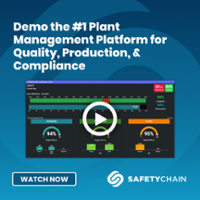A Primer on Preventive Maintenance - How It Benefits Your Plant
“An ounce of prevention is worth a pound of cure.” —Benjamin Franklin.
What Is Preventive Maintenance?
Even the best-built equipment will break down over time and need maintenance. Much like taking a car in for regularly scheduled oil changes, preventive maintenance is planned maintenance that a facility performs on its equipment to reduce the risk of failure. Also sometimes referred to as preventative maintenance, the goal is always to incur a lower cost in the present to prevent a higher cost from equipment breakdown in the future.
What Are the Types of Preventive Maintenance?
There are five different types of preventive maintenance. These include:
Time-based: This type of preventive maintenance occurs according to a calendar schedule. For instance, there are guidelines for when specific pieces of equipment must be checked for proper lubrication according to both industry regulations and OEM (original equipment manufacturer) standards.
Condition-based: Facilities may opt to perform maintenance outside of time-based maintenance based on observations of how the equipment looks, sounds, or functions. If a part appears worn, frayed, or otherwise damaged, condition-based maintenance at the time of observation can prevent a more extensive issue from developing over time.
Risk-based: Facilities often identify specific parts of their equipment that would create more costly or time-consuming problems if they fail and choose to perform preventive maintenance based on that risk.
Failure finding: Operators use tasks to look for or predict failures in the equipment or systems designed to protect the processes. The goal is to prevent a breakdown in the processes and the equipment simultaneously.
Predictive: By analyzing data either manually or using software, predictive maintenance searches for clues in the data to determine when a part or process is most likely to fail.
When Is Preventive Maintenance Required?
There are several reasons why preventive maintenance schedules can look different from one facility to another. Equipment comes with recommendations from the OEM for performing some maintenance tasks. An added layer is the industry standards, based on historical data from many facilities and companies. Beyond time-based maintenance, manufacturers also may perform maintenance outside of the regular schedule due to condition-based issues. Some facilities also choose to complete failure-finding activities or assess risk based on enterprise-level guidance.
What Is the Difference Between Preventive Maintenance and Corrective Maintenance?
While preventive maintenance is proactive, corrective maintenance is reactive. Facilities perform corrective maintenance once the equipment has already failed. Sometimes even the best-laid preventative maintenance plans still do not prevent all failures. Relying solely on preventive or corrective maintenance alone is inefficient, so facilities often create plans that include both. Corrective and preventive action (CAPA) plans are an essential part of continuous improvement. To stay competitive, manufacturers use continuous improvement to drive ongoing improvement in every aspect, from processes to equipment functions, and often in many other parts of the business.
CAPA and Preventive Maintenance Software
Corrective and preventive action plans collect and analyze data to determine the problems and then provide solutions. Maintenance Software performs data collection and analysis in real-time to create a detailed and multifaceted approach to quality and production issues. Preventive and corrective maintenance is key to developing and implementing a robust CAPA.
Like many other data collection methods, resolving potential and realized problems is more cost-effective when operations occur in real-time. Shutting down even a small part of the line to perform maintenance can add up quickly. While many companies schedule maintenance outside of work hours, sometimes this isn’t possible. Efficiency is crucial in a competitive industry.
What Is the Difference Between Preventive Maintenance and Predictive Maintenance?
Preventive and predictive maintenance are often confused, but there are crucial differences in both maintenance types. Preventative maintenance is schedule-based, meaning that maintenance is performed at regularly-scheduled intervals even if the equipment is operating smoothly. Predictive maintenance essentially relies on making well-informed predictions or guesses about when a part or equipment may fail and taking steps to repair and maintain it before that event can happen. Predictive maintenance can become a scheduled event utilizing software and analytical models, but it is not schedule-based. Implementing predictive maintenance can have an initial cost because facilities may need to train some employees or invest in software.
In a nutshell, preventive maintenance happens regardless of need, while predictive maintenance is need-based but happens before corrective maintenance.
What Are the Benefits of Preventive Maintenance?
Companies invest significant amounts in the equipment used to produce goods. Regularly scheduling and completing preventive maintenance allows facilities to save money on equipment, by prolonging its life and productive value. Corrective maintenance is often extremely costly. It may occur during normal work hours, resulting in operators who are not producing but are still paid for their time. It can also mean that the repair or replacement of equipment is far more expensive since unaddressed, more minor problems may have caused damage to additional parts. Failure to perform preventive maintenance can also cause product waste if batches become contaminated or fail to comply with standards. Finally, preventive maintenance is valuable because it creates a safer work environment. Unmaintained equipment can fail catastrophically, injure workers, or lead to product contamination that creates unsafe products for consumers.
Is Preventive Maintenance Too Costly?
When every moment of downtime feels like a hit to the bottom line, it can be challenging to stick to preventive maintenance schedules. While it may satisfy the finance team in the short term to skip preventive maintenance due to the cumulative costs, the savings will quickly dissipate when the more significant equipment failures roll in. Failure to adequately implement preventive maintenance can lead to noncompliance, auditing headaches, and environmental health and safety (EHS) violations. Staying on top of preventive maintenance schedules and pairing preventive maintenance with a robust corrective action plan when things go wrong is an investment that will keep processes running smoothly and consistently add value by driving continuous improvement.



